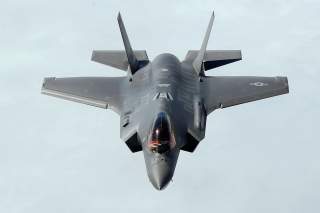Yes Turkey Is Trying to Build Its Own "F-35" Like Stealth Fighter
Can Ankara pull it off?
Key point: Ankara wants a homemade stealth program, but that technology is complicated and very costly. Turkey could succeed, but it likely won't be as good as the F-35.
Turkey’s recent ejection from the F-35 program has spawned a wave of speculation as to the fate of Ankara’s procurement plans.
The Su-35, Eurofighter Typhoon, and Saab JAS 39 Gripen were advanced as prospective alternatives, with the former being seen as a particularly attractive option on the heels of the diplomatic goodwill generated by Turkey’s decision to import Russia’s S-400 system. But it is now emerging that the Turkish defense industry is actively pursuing an altogether different path: its own, domestically-built fifth-generation aircraft.
Turkish Aerospace Industries (TAI) displayed an early pre-production model of their twin-engine TF-X fighter at last month’s Paris Air Show. TAI CEO TAI Temel Kotil is confident that the TF-X will enter serial production over the coming decade: “Our machine is a mock-up, but in 2023 there will be a real machine, and first flight is in 2025, and [it will be in] service in 2028,” he said at the unveiling. Kotil’s optimistic forecast is borne from TAI’s prior involvement with the F-35 partner program: “On the F-35, actually, my company is building the center fuselage.. so this means, in terms of manufacturing, Turkish Aerospace has enough strength to build this fighter.”
TAI’s current cited specifications include a top speed of Mach 2, a 600-mile effective combat radius, a maximum takeoff weight of 60,000 pounds. In other words, the TF-X not only physically resembles the F-35 but boasts a similar hardware specifications sheet. Replicating an already-proven design would seem to be a cost-effective recipe for success, but- the F-35’s calling card has always been its unique avionics suite: namely, information fusion, the ability to double as an AWACS platform, and comprehensive AI integration on and off the battlefield. Lockheed Martin could only achieve such a sophisticated avionics package by making conscious trade-offs in the raw performance department, where the F-35 is largely outperformed by the competing Russian Su-57.
And therein lies the danger of Turkey modeling the TF-X fighter too closely after the F-35; given the likelihood that they lack the resources and license to reproduce the F-35’s avionics, the Turkish defense industry stands to inherit all of the F-35’s weaknesses while failing to capture its strengths.
There is, however, an even more salient problem plaguing Turkey’s foray into fifth-generation fighter production: exorbitant costs. The TF-X program commands an initial price tag of $13 billion, but a recent spat with a crucial component manufacturer stands to inflate that already-hefty price. British car and aircraft engine manufacturer Rolls-Royce was on the verge of partnering with local Turkish firms to jointly produce the TF-X’s engine. Ongoing intellectual property disputes have led Rolls-Royce to “all but abandon” its efforts to secure the bid, generating still greater uncertainty concerning the logistics of the TF-X project. Initial plans to ship the first serially-produced TF-X models with the General Electric F110 engine have likewise fallen by the wayside, as Ankara fears that the use of US components or systems in the construction would invite US sanctions.
Nevertheless, the Turkish defense sector is forging ahead with the TF-X; according to Turkish media, 400 orders have already been placed following the Paris Air Show presentation.
Turkish interest in developing a homegrown fighter predates the ongoing F-35 scandal by a decade, stretching back to 2010 with TAI’s early plans to design a “Turkish Type Fighter.” While recent tensions in the Turkey-NATO relationship have generated a newfound political will in Ankara to see it through, the project continues to wrestle with serious questions of financial solvency.
Mark Episkopos is a frequent contributor to The National Interest and serves as research assistant at the Center for the National Interest. Mark is also a PhD student in History at American University. This article was originally published earlier in 2019 and is being republished due to reader interest. Image: Reuters.

